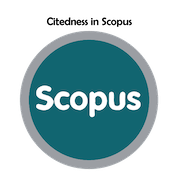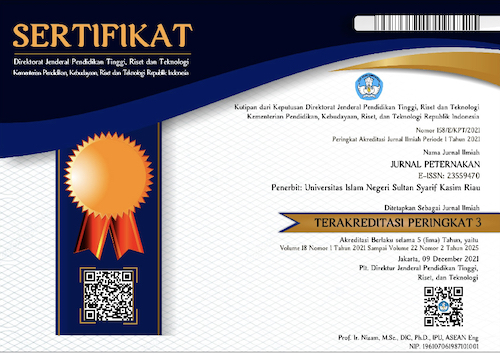Sistem Produksi dan Produktivitas Itik Manila Lokal di Pulau Lombok
Abstract
ABSTRAK. Itik Manila merupakan salah satu plasma nutfah yang mempunyai kontribusi signifikan sebagai penyangga ketahanan pangan nasional, namun belum banyak tersedia data sistem produksi dan kinerja produksinya. Penentuan sampel wilayah penelitian dilakukan dengan metode purposive sampling, sedangkan jumlah sampel dilakukan dengan metode quantitative sampling. Data diperoleh dengan mewawancarai masing-masing 50 responden (peternak itik Manila) di daerah basah dan kering, serta 30 responden di daerah padat penduduk pulau Lombok yang ditentukan menggunakan metode Snowball. Untuk mengetahui pola produksi dan produktivitas itik Manila dilakukan pengamatan langsung ke lokasi usaha, dan melakukan pengukuran performa produksi pada masing-masing peternak. Pelaksanaan wawancara dibantu oleh daftar pertanyaan serta alat ukur berupa timbangan merk ohaus kapasitas 5 kg dan kepekaan 1 g. Data yang diperoleh ditabulasi dan dianalisis secara deskriptif. Hasil penelitian mendapatkan bahwa pemeliharaan itik Manila di pulau Lombok sebagian besar menggunakan sistem semi intensif dengan menggunakan dedak padi dan atau nasi aking sebagai pakan, sedangkan di daerah padat penduduk, pakan itik Manila dicampur ampas tahu. Performa produksi itik Manila lokal Lombok di daerah padat penduduk relatif lebih baik dibandingkan dengan itik Manila dari daerah kering dan basah.
Kata kunci: itik Manila, performa produksi, bobot badan, konsumsi pakan, ampas tahu
Production System and Productivity of Local Muscovy Duck, Lombok Island
ABSTRACT. Muscovy duck is one of the germplasm that has a significant contribution in Indonesia’ national food security. However, data of the duck’ production system and production performance are not yet available. The study was conducted on the island of Lombok by determining the sample area using the purposive sampling method, while the number of samples was determined by the quantitative sampling method. The data was obtained by interviewing 50 respondents (Muscovy duck farmers) in wet and dry areas, and 30 respondents in the suburbs of Lombok Island, which were determined using the snowball method. To determine the pattern of the production and the productivity of Muscovy duck s, direct observations were made to business locations and productions of each breeder’s performance were measured. The interview was assisted by a list of questions and measuring instruments in the form of an Ohaus brand scale with a capacity of 5 kg and a sensitivity of 1 gram. The data obtained were tabulated and analyzed descriptively. The results showed that the maintenance of local Muscovy duck s on the island of Lombok uses a semi-intensive system using rice bran and or aking rice as feed, while in suburban areas, Muscovy duck feed is mixed with tofu dregs. The production performance of local Muscovy duck s in Lombok in densely populated areas is relatively better than that of Muscovy duck s from dry and wet areas.
Keywords
Full Text:
PDF (Bahasa Indonesia)References
Ali M., S. Sukirno, M.H. Tamzil & M. Ichsan. 2014. Meat Traits of Muscovy Ducks Fed on Phytonutrition Meal. Int. J. Poult. Sci. 13 (4): 204-207.
Ayuningtyas, G., Jakaria, Rukmiasih, & C. Budiman. 2016. Produktivitas Entok Betina dengan Pemberian Pakan Terbatas Selama Periode Pertumbuhan. Jurnal Ilmu Produksi dan Teknologi Hasil Peternakan. 04(2): 280-285
Baéza, E. 2016. Nutritional requirements and feed management of meat type ducks. World's Poultry Science Journal, Vol. 72, March 2016. doi:10.1017/S004393391500272X
Chen, X., D. Shafer, M. Sifri, M. Lilburn, D. Karcher, P. Cherry, P. Wakenell, S. Fraley, M. Turk & G. S. Fraley. 2021. Centennial Review: History and husbandry recommendations for raising Pekin ducks in research or commercial production. Poult. Sci. 100:101241. https://doi.org/10.1016/j.psj.2021.101241
Dean, 2001. Nutrient Requirement of meat – Type ducks dalam Duck production Science and world Practise. Printed and Published by the University of New England, armilade.
Etuk, I. F., G.S. Ojewola, S Akomas, E.B. Etuk & I.P. Ogbuewu. 2011. Egg production potentials of Muscovy ducks (Cairina moschata) Raised under three management systems in the humid tropics. Nigerian J. Anim. Sci. 2011, 13:70-75.
Gaafar, K.M. S.A. Selim, & S.S. El-ballal. 2013. Effect of in-ovo administration with two levels of amino acids mixture on the performance of muscovy ducks. Emir. J. Food Agric. 2013. 25 (1): 58-65. DOI https://doi.org/10.9755/ejfa.v25i1.9666 http://www.ejfa.info/
Ismoyowati, I.H. Sulistyawan, S. Mugiyono & Rosidi. 2019. Carcass production and single nucleotide polymorphism Adipocyte Fatty acid binding protein (A-Fabp) gene on Cairina moschata. The 1st Animal Science and Food Technology Conference. IOP Conference Series: Earth Environment Science. 372:012067.
Kementan, 2019. Statistik Peternakan dan Kesehatan Hewan. Direktorat jendral Peternakan dan Kesehatan Hewan. Kementrian Pertanian Republik Indonesia Jakarta.
Kementan, 2021. Statistik Peternakan dan Kesehatan Hewan. Direktorat Jendral Peternakan dan Kesehatan Hewan. Kementrian Pertanian Republik Indonesia Jakarta.
Lestari, E., Ismoyowati & Sukardi. 2013. Korelasi antara bobot telur dengan bobot tetas dan perbedaan susut bobot pada telur entok (Cairina moschata) dan itik (Anas plathyrhincos). J. Ilmiah Peternakan.1(1):163-169
Lin, R.L., R.Rouvier, & C. Marie-Etancelin. 2016. Genetic parameters of body weight, egg production, and shell quality traits in the Shan Ma laying duck (Anas platyrhynchos).
Poult. Sci. 95(11): 2514-2519
NRC. 1994. Nutrient Requirements of Poultry: Ninth Revised Edition, 1994. Washington, DC: The National Academies Press
Oguntunj, O. 2017. Regression tree analysis for predicting body weight of Nigerian Muscovy duck (Cairina moschata). Genetika 49(2). DOI:10.2298/GENSR1702743O
Purba, M., & P.P. Ketaren. 2012. Konsumsi dan konversi pakan itik lokal jantan umur delapan minggu dengan penambahan santoquin dan vitamin E dalam pakan. JITV. 16:280287.
Putra, A, R. Rukmiasih & R. Afnan. 2015. Persentase dan kualitas karkas itik Cihateup-Alabio (CA) pada umur pemotongan yang berbeda. J Ilmu Prod Teknol Hasil Peternak. 3:27-32.
Putra, A., T.G. Pradana, & D. Alfachri. 2022. Analisis Morfometrik Ternak Itik Manila (Cairina moschata) di Kecamatan Hamparan Perak Kabupaten Deli Serdang. Jurnal Ilmu Peternakan dan Veteriner Tropis. 12(2):136–142. DOI: https://doi.org/10.46549/jipvet.v12i2.215
Rahman, MM., MJ. Khan, & S D Chowdhury. 2020.
A study on the comparative growth performance of three genotypes of ducklings with or without supplementary feeding in coastal areas of Bangladesh. Bangladesh J. Livest, Res. 20(1-2):33-41. DOI:10.3329/bjlr.v20i1-2.47016
Ribeiro, B.P.V.B., T.Y.Junior, D. D. de Oliveira, R.R, de Lima & M.G.Zangeronimo. 2020. Thermoneutral zone for laying hens based on environmental conditions, enthalpy and thermal comfort indexes. J. Therm. Biol. 93, October 2020, 102678. https://doi.org/10.1016/j.jtherbio.2020.102678
Suci, D.M, Z. Fitria & R. Mutia. 2017. Meat Fatty Acid and Cholesterol Content of Native Indonesian Muscovy Duck Fed with Rice Bran in Traditional Farm. Anim. Prod. 19(1):37-45, 2017 ISSN 1411-2027.
Susanti, T. 2021. Strategi Pembibitan Itik Manila Lokal dalam Mendukung Pengembangan Ternak Itik Potong. WARTAZOA. 31 (3): 109-118.
Tamzil, M. H. 2014. Stres panas pada unggas: metabolisme, akibat dan upaya penanggulangannya. Wartazoa. 24:57-66.
Tamzil, M.H. 2018. Sumber daya genetik itik Manila (Cairina moschata): profil dan potensi produksi sebagai penghasil daging. Wartazoa. 28:129-138.
Tamzil, M.H., L. Lestari & B. Indarsih. 2018. Measurement of several qualitative traits and body size of Lombok Muscovy Ducks (Cairina moshcata) in semi-intensive rearing. J. Indonesian Trop. Anim. Agric. 43 (4): 333-342.
Tamzil, MH. 2017. Ilmu dan Teknologi Pengelolaan Plasma Nutfah Ternak Itik. Mataram University Press. Mataram.
Tugiyanti, E., T. Yuwanta, Z. Zuprizal & R. Rusman. 2013. Improving Performance, Meat Quality and Muscle Fiber Microstructure of Native Indonesian Muscovy Duck Through Feed Protein and Metabolizable Energy. Inter. J. Poult. Sci. 12(11):653-659. DOI:10.3923/ijps.2013.653.659.
Weis, J. , C. Hrnčár, G. Pál , B. Baraňska , J. Bujko & L. Malíková. 2011. Effect of the Egg Size on Egg Loses and Hatchability of the Muscovy Duck. /Scientific Papers: Animal Science and Biotechnologies, 2011, 44 (1)
Widianingrum, D., T. Widjastuti, A. Anang, & I. Setiawan. 2011. Comparison Production and Reproduction Performof Muscovy Duck from Different Regions. Sys Rev Pharm 2020;11(12):527-533
Xu, G., X. Liu, Q. Wang & X. Yu. 2017. Integrated rice-duck farming mitigates the global warming potential in rice season. Sci.Tot. Environ. DOI:10.1016/j.scitotenv.2016.09.233
DOI: http://dx.doi.org/10.24014/jupet.v20i2.19420
Refbacks
- There are currently no refbacks.
Jurnal Peternakan has been accredited by Sinta 3 : Number 158/E/KPT/2021
Starting from Vol. 18 No. 1 Year 2021 to Vol. 22 No. 2 Year 2025
Jurnal Peternakan Indexed By:
Editorial Office:
Jurnal Peternakan
Faculty of Agriculture and Animal Science, State Islamic University of Sultan Syarif Kasim Riau.
H.R. Soebrantas street KM. 15,5 Panam – Pekanbaru city.
E-mail: jurnal.peternakan@uin-suska.ac.id
ejournal: http://ejournal.uin-suska.ac.id/index.php/peternakan

Creation is distributed under the Creative Commons Attribution 4.0 International License. View Mystats















